南锣鼓巷中英文介绍
- 格式:docx
- 大小:2.69 MB
- 文档页数:4
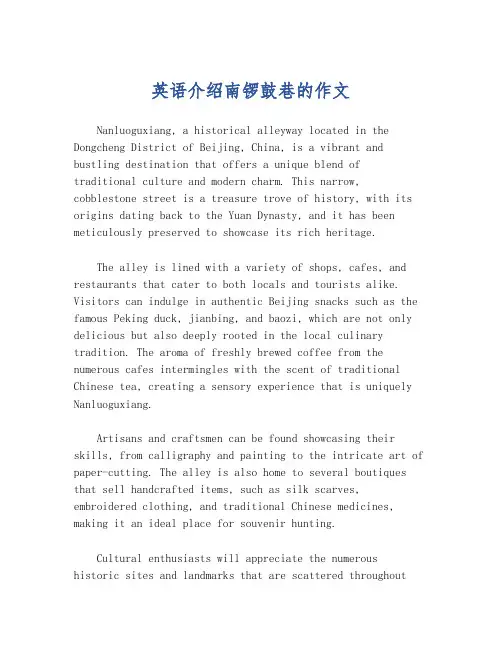
英语介绍南锣鼓巷的作文Nanluoguxiang, a historical alleyway located in the Dongcheng District of Beijing, China, is a vibrant and bustling destination that offers a unique blend oftraditional culture and modern charm. This narrow, cobblestone street is a treasure trove of history, with its origins dating back to the Yuan Dynasty, and it has been meticulously preserved to showcase its rich heritage.The alley is lined with a variety of shops, cafes, and restaurants that cater to both locals and tourists alike. Visitors can indulge in authentic Beijing snacks such as the famous Peking duck, jianbing, and baozi, which are not only delicious but also deeply rooted in the local culinary tradition. The aroma of freshly brewed coffee from the numerous cafes intermingles with the scent of traditional Chinese tea, creating a sensory experience that is uniquely Nanluoguxiang.Artisans and craftsmen can be found showcasing their skills, from calligraphy and painting to the intricate art of paper-cutting. The alley is also home to several boutiques that sell handcrafted items, such as silk scarves, embroidered clothing, and traditional Chinese medicines, making it an ideal place for souvenir hunting.Cultural enthusiasts will appreciate the numeroushistoric sites and landmarks that are scattered throughoutthe area. The Drum Tower and Bell Tower, which are within walking distance, offer a glimpse into the ancient timekeeping practices of the city. The Confucius Temple, another nearby attraction, provides insight into the philosophical and educational foundations of Chinese society.Nanluoguxiang is not just a place to shop and eat; it's an experience that immerses visitors in the heart ofBeijing's culture and history. As the sun sets and the lanterns are lit, the alley takes on a magical glow, transforming into a lively night market where street performers entertain the crowds and the air is filled with laughter and the clinking of glasses.Whether you're a history buff, a foodie, or simply someone looking for a memorable experience, Nanluoguxiang is a must-visit destination that promises to leave a lasting impression on your heart and taste buds.。
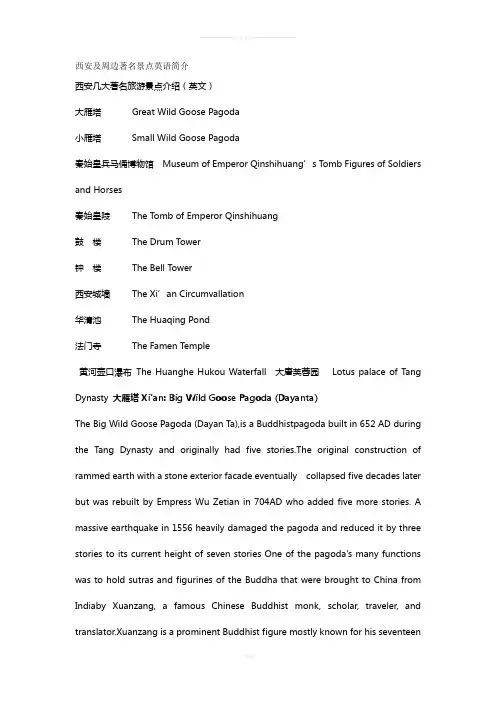
西安及周边著名景点英语简介西安几大著名旅游景点介绍(英文)大雁塔Great Wild Goose Pagoda小雁塔Small Wild Goose Pagoda秦始皇兵马俑博物馆Museum of Emperor Qinshihuang’s Tomb Figures of Soldiers and Horses秦始皇陵The Tomb of Emperor Qinshihuang鼓楼The Drum Tower钟楼The Bell Tower西安城墙The Xi’an Circumvallation华清池The Huaqing Pond法门寺The Famen T emple黄河壶口瀑布The Huanghe Hukou Waterfall 大唐芙蓉园Lotus palace of Tang Dynasty 大雁塔Xi'an: Big Wild Goose Pagoda (Dayanta)The Big Wild Goose Pagoda (Dayan T a),is a Buddhistpagoda built in 652 AD during the Tang Dynasty and originally had five stories.The original construction of rammed earth with a stone exterior facade eventually collapsed five decades later but was rebuilt by Empress Wu Zetian in 704AD who added five more stories. A massive earthquake in 1556 heavily damaged the pagoda and reduced it by three stories to its current height of seven stories One of the pagoda's many functions was to hold sutras and figurines of the Buddha that were brought to China from Indiaby Xuanzang, a famous Chinese Buddhist monk, scholar, traveler, and translator.Xuanzang is a prominent Buddhist figure mostly known for his seventeenyear overland trip to India and back, which is recorded in detail in his autobiography and a biography, and which provided the inspiration for the epic novel “Journey to the West”. The pagoda is built on the premises of the Temple of Great Maternal Grace (Da Ci'en), originally built in 589 AD and then rebuilt 647 AD by the T ang Emperor Gaozong in memory of his mother EmpressWende. Before the gates of the temple stands a statue of Xuanzang.大雁塔北广场North Square of Big Wild Goose PagodaSurrounding Big Wild Goose Pagoda, the scenery is also quite charming, especially the square north of the Da Ci'en Temple. Covering about 110,000 square meters (131563 square yards) plus 20,000 square meters (23920.6 square yards) of water area, it holds many records: in Asia, it is the biggest T ang-culture square, the biggest fountain and waterscape square, and the largest-scale sculptures area. In the world, it has the most benches, the longest light-belt, and the largest-scale acoustic complex. The entire square is composed of waterscape fountains, a cultural square, gardens and tourist paths. There you can taste real Chinese culture and traditions and fully enjoy the truly attractive views. With reliefs on the theme of the prosperous T ang Dynasty, 200-meter-long (656-foot-long) sculpture groups, 8 groups of sculpted figures, 40 relievos on the land, and 22 styles of musical fountains, it has become a must-see when you visit Big Wild Goose秦始皇兵马俑The Museum of Qin Terra-cotta Warriors and HorsesOne of the most significant archaeological finds in the world, this 16,300-square-meter excavation reveals more than 7,000 life-size terracotta figuresof warriors and horses arranged in battle formations. (3 pits) The terracotta warriors and horses, created about 2,200 years ago, were found in 1974 on the east side of the tomb of the First Emperor Qin Shihuang (259 BC - 210 BC) near Xi'an. Emperor Qin Shihuang had Ying as his surname and Zheng as his given name. In 221 B.C., when he unified the whole country, named himself Shihuang Di and carried on the hereditary system. To protect against harassment by the Hun aristocrats. Emperor Qin Shihuang ordered the Great Wall be built.钟楼The Bell Tower (Zhonglou)Centrally located on the "Four Main Roads" junction is the Bell Tower, of Xi'an. The original City Bell Tower was constructed in 1582 and situated in the west, but on its reconstruction in 1739, the tower was relocated to its present site. A Ming dynasty bell weighing approximately 14.76 tons hangs in the tower, but no longer chimes to inform residents of the time of day. Visitors have the chance to inspect up-close a number of smaller bells. Although the site itself is more of a landmark than an attraction, it is frequently enlivened with local performances. Visitors interested in local music should visit the site in the morning and early afternoon. Originally, the tower had a number of entrances, but today, it only has one accessible entrance located on Bei Dajie close to the Admission Ticket Office.鼓楼Xi'an: Drum Tower (Gulou)The Drum Tower was built in 1380 during the early Ming Dynasty, and got its name from the hugedrum located within the building. In contrast to the Bell Tower ,where bell was stricken at dawn, drum was beat at sunset to indicate the end ofthe day.There are twenty-four drums in the northand south sides of the Drum Tower . These drums standfor the Twenty-four Solar Terms, a form of weather calendar created by theChinese in order to guide the agricultural production.西安城墙The Xi’an CircumvallationThe Xi’an Circumvallation site is located at the center of xi’an ci ty with the form of a rectangular. The circumvallation, with its wall height of 12 meters, bottom width of 18 meters and top width of 15 meters, consists of 4 city gates: changle gate to the east, anding gate to the west, yongling gate to the south and anyuan gate to the north. Its east wall has the length of 2590 meters, west wall of 2631.2 meters, south wall of 3441.6 meters and north wall of 3241 meters. It was constructed on the basis of the tang imperial city and under the strategic consideration of defense. The thickness of the wall is larger than its height and is very solid that cars can run on it. The existing circumvallation was built during 1373-1378 with the history of more than 600 years. It is one of the most famous wall construction in China’s history after the middle ages as well as the most preserved ancient one in China.小雁塔Small Wild Goose PagodaThe Small Wild Goose Pagoda, sometimes Little Wild Goose Pagoda (Chinese: 小雁塔; pinyin: Xiǎoyàn Tǎ), is one of two significant pagodas in the city of Xi'an, China, the site of the old Han and Tang capital Chang'an. The other notable pagoda is the Giant Wild Goose Pagoda, originally built in 652 and restored in 704. The Small Wild Goose Pagoda was built between 707–709, during the Tang Dynasty underEmperor Zhongzong of Tang (r 705–710). The pagoda stood 45 m (147 ft) until the 1556 Shaanxi earthquake. The earthquake shook the pagoda and damaged it so that it now stands at a height of 43 m (141 ft) with fifteen levels of tiers.[1] The pagoda has a brick frame built around a hollow interior, and its square base and shape reflect the building style of other pagodas from the era.[1] During the Tang Dynasty, the Small Wild Goose Pagoda stood across a street from its mother temple, the Dajianfu Temple. Pilgrims brought sacred Buddhist writings to the temple and pagoda from India, as the temple was one of the main centers in Chang'an for translating Buddhist texts.[1] The temple was older than the pagoda, since it was founded in 684, exactly 100 days after the death of Emperor Gaozong of Tang (r. 649–683).[1] Emperor Zhongzong had donated his residence to the building of a new temple here, maintaining the temple for 200 monks in honor of his deceased father Gaozong.[1] The temple was originally called the Daxianfusi or Great Monastery of Offered Blessings by Zhongzong, until it was renamed Dajianfusi by Empress Wu Zetian in 690.华清池Huaqing Hot SpringsHuaqing Hot Springs, also known as Huaqing Palace, is a well-known historic site and an AAAAA tourist attraction of China. It gets its fame for being the place where the romantic story of Emperor T angxuanzong of Tang Dynasty (618-907) and his beloved Yang Guifei (or Concubine Yang) took place. As a matter of fact, the site had been as an imperial palace for emperors' short stays away from the capital for more than 3000 years. Emperors of Zhou, Qin, Han, Sui and Tang dynasties spentthe winter at this place every year. Emperor Zhouyouwang of Western Zhou Dynasty (1046BC-771BC) is said to be the first emperor who ordered to build a palace at the site. In the following dynasties, the palace was repaired and expanded for several times, given the name of "Hot Spring Palace" and finally denominated "Huaqqing Palace" by Emperor Tangxuanzong. The palace was constructed above hot springs, hence the site is also called "Huaqing Hot Springs".法门寺The Famen TempleFamen Temple, renowned for storing the veritable Finger Bone of the Sakyamuni Buddha, is located in Fufeng County of Shaanxi Province. Famen Temple was established in the Eastern Han Dynasty (25--220) for spreading Buddhism. The most representative structures in the temple are the Famen Temple Pagoda and Famen Temple Museum. Many royal treasures and jewelry were found here. But why? Famen Temple was the royal temple during the Sui Dynasty (581-618) and Tang Dynasty. Emperors in Sui and T ang believed that enshrining and worshiping the bone of Sakyamuni would bring richness and peace to the land and its people. So an offering of treasure to the finger bone was made, which was housed in the Underground Palace.壶口瀑布Hukou WaterfallThe Hukou waterfall on the Huanghe River west of Jixian County, Shanxi, is formed when the river flows to the Hukou Mountains on the Shanxi-Shaanxi border and its 250-meter-wide bed, sandwiched between the canyons on its banks, abruptly narrows into a trough 50 meters wide and 30 meters deep and falls down into a bigstone-strewn pool. The section of the river here is like the mouth of a water-flash. Hence the name of the waterfall, wh ich means “ Flask Mouth waterfall”. The waterfall has a descent of 15-20 meters in the low-water season, but it is scarcely noticeable as a waterfall in the high –water season when the waters burst into rapid torrents. The section is rich in hydroelectric power potential陕西历史博物馆Xi'an: Shanxi History MuseumOne thing surprising at the Shaanxi Provincial History Museum was the fact that it is possible, even expected, to bargain for the items sold at the gift shops. One would assume that a museum would have fixed prices. It turns out that ithe prices provide are only the starting price. You should bargain for everything you buy at the gift shop. You can expect to save at least 50%, possibly more.大唐芙蓉园Lotus palace of Tang Dynasty (Tang Paradise)Tang Para dise lies in the Qujiang New District, Xi’An City, Shannxi Province, with 66.7 hectares building areas and 20 hectares of lake areas inside. The garden is the biggest culture theme part in Northwest China, with 1.3 billion RMB investments. The Tang Paradise, which was rebuilt at the north of archaeological site of Lotus Palace of Tang Dynasty, is the first large scale royal garden culture theme garden which fully exhibits the living styles and features of Glorious age of Tang Dynasty. In this project, we c reated a unique night view of “Splendid and magnificent, Glorious age of Tang Dynasty”, by fully controlling the combination of “Lighting” and “Shadow”。
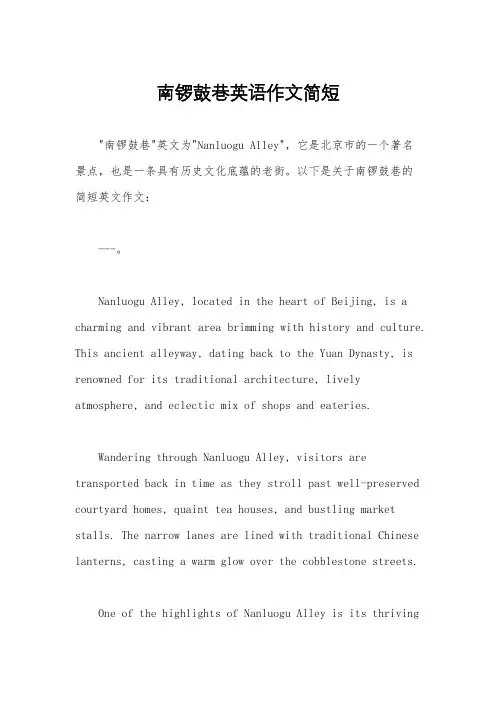
南锣鼓巷英语作文简短"南锣鼓巷"英文为"Nanluogu Alley",它是北京市的一个著名景点,也是一条具有历史文化底蕴的老街。
以下是关于南锣鼓巷的简短英文作文:---。
Nanluogu Alley, located in the heart of Beijing, is a charming and vibrant area brimming with history and culture. This ancient alleyway, dating back to the Yuan Dynasty, is renowned for its traditional architecture, lively atmosphere, and eclectic mix of shops and eateries.Wandering through Nanluogu Alley, visitors are transported back in time as they stroll past well-preserved courtyard homes, quaint tea houses, and bustling market stalls. The narrow lanes are lined with traditional Chinese lanterns, casting a warm glow over the cobblestone streets.One of the highlights of Nanluogu Alley is its thrivingarts and crafts scene. Here, local artisans showcase their talents in everything from calligraphy and painting to pottery and paper cutting. Visitors can watch skilled craftsmen at work or even try their hand at creating their own masterpiece.In addition to its cultural attractions, Nanluogu Alley is also a food lover's paradise. From authentic Beijing snacks like "jianbing" (savory crepes) and "roujiamo" (Chinese hamburgers) to international cuisine and trendy cafes, there's something to satisfy every palate. Dining al fresco at one of the charming courtyard restaurants is a must-do experience.Beyond its historical significance and culinary delights, Nanluogu Alley exudes a palpable energy that is infectious. Street performers entertain crowds with music, dance, and acrobatics, adding to the lively atmosphere. Whether it's browsing for unique souvenirs, sipping tea in a tranquil courtyard, or simply soaking in the vibrant ambiance, there's no shortage of things to see and do in Nanluogu Alley.In conclusion, Nanluogu Alley is a treasure trove of culture, history, and gastronomy nestled in the heart of Beijing. Its timeless charm and dynamic spirit make it a must-visit destination for tourists and locals alike.。
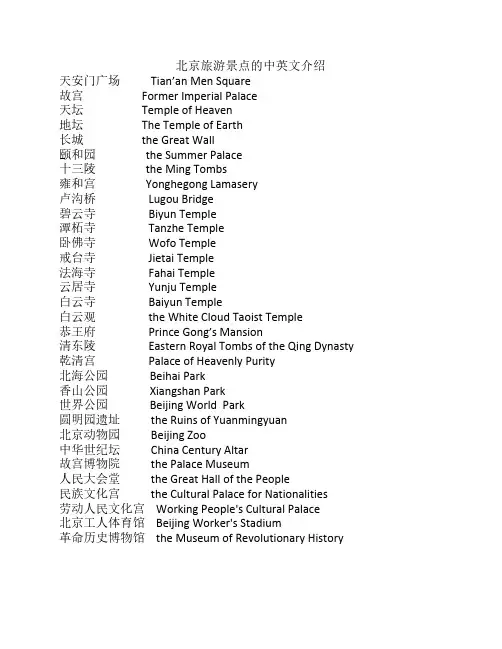
北京旅游景点的中英文介绍天安门广场 Tian’an Men Square故宫 Former Imperial Palace天坛 Temple of Heaven地坛 The Temple of Earth长城 the Great Wall颐和园 the Summer Palace十三陵 the Ming Tombs雍和宫 Yonghegong Lamasery卢沟桥 Lugou Bridge碧云寺 Biyun Temple潭柘寺 Tanzhe Temple卧佛寺 Wofo Temple戒台寺 Jietai Temple法海寺 Fahai Temple云居寺 Yunju Temple白云寺 Baiyun Temple白云观 the White Cloud Taoist Temple恭王府 Prince Gong’s Mansion清东陵 Eastern Royal Tombs of the Qing Dynasty 乾清宫 Palace of Heavenly Purity北海公园 Beihai Park香山公园 Xiangshan Park世界公园 Beijing World Park圆明园遗址 the Ruins of Yuanmingyuan北京动物园 Beijing Zoo中华世纪坛 China Century Altar故宫博物院 the Palace Museum人民大会堂 the Great Hall of the People民族文化宫 the Cultural Palace for Nationalities劳动人民文化宫 Working People's Cultural Palace北京工人体育馆 Beijing Worker's Stadium革命历史博物馆 the Museum of Revolutionary History。
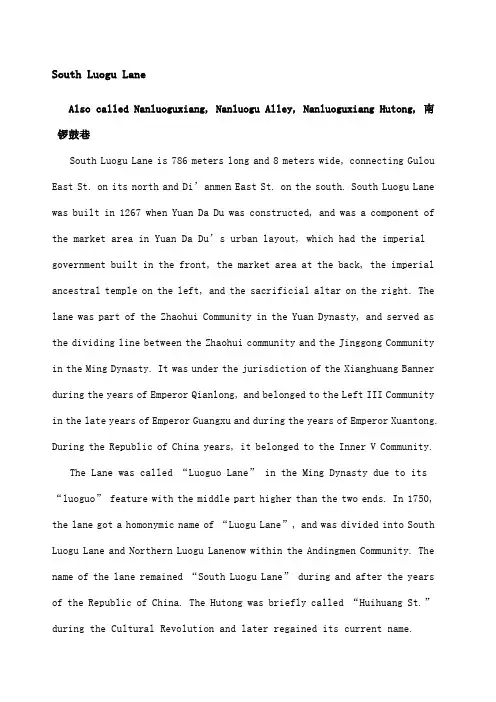
South Luogu LaneAlso called Nanluoguxiang, Nanluogu Alley, Nanluoguxiang Hutong, 南锣鼓巷South Luogu Lane is 786 meters long and 8 meters wide, connecting Gulou East St. on its north and Di’anmen East St. on the south. South Luogu Lane was built in 1267 when Yuan Da Du was constructed, and was a component of the market area in Yuan Da Du’s urban layout, which had the imperial government built in the front, the market area at the back, the imperial ancestral temple on the left, and the sacrificial altar on the right. The lane was part of the Zhaohui Community in the Yuan Dynasty, and served as the dividing line between the Zhaohui community and the Jinggong Community in the Ming Dynasty. It was under the jurisdiction of the Xianghuang Banner during the years of Emperor Qianlong, and belonged to the Left III Community in the late years of Emperor Guangxu and during the years of Emperor Xuantong. During the Republic of China years, it belonged to the Inner V Community.The Lane was called “Luoguo Lane” in the Ming Dynasty due to its “luoguo”feature with the middle part higher than the two ends. In 1750, the lane got a homonymic name of “Luogu Lane”, and was divided into South Luogu Lane and Northern Luogu Lanenow within the Andingmen Community. The name of the lane remained “South Luogu Lane” during and after the years of the Republic of China. The Hutong was briefly called “Huihuang St.”during the Cultural Revolution and later regained its current name.South Luogu Lane was built under the architectural concept of “residential blocks”–with the lane serving as the central line dividing 8 parallel Hutongs on each side, hence forming the outlook of a fish bone, or a “Wugong”. Thus, the lane was also called “Wugong Lane”. South Luogu Lane is the only remaining traditional residential area in China that still fully preserves the chess-board style layout of Hutongs typically found in the Yuan Dynasty, with its scale, quality and historical value unmatched by any other lanes.South Luogu Lane was among the first 25 areas listed for historical preservation by the Beijing Municipal Government in November 1990. Currently, within the South Luogu Lane area, one site has been listed for national level preservation, 11 sites for municipal level preservation, and 9 sites for district level preservation. With its impressive historical and cultural legacy, South Luogu Lane has become an attractive area for tourism and cultural creativity in the ancient capital Beijing.Today, South Luogu Lane is among one of the oldest Hutongs around and has a history of over 800 years. This near 800-meter long North-South alleyway is filled with bars, cafes, restaurants, artsy little shops, souvenir shops and cute boutiques. It's worth to spend an hour or two walking through the little alley ways and Hutongs around it.Location:South Luogu Lane is situated at Beijing’s Dongcheng District, near the with its northern end at Gulou Dongdajie Drum Tower East Street, 鼓楼东大街 Walk East along Guloudong Dajie about 10-15min past the Drum Tower and look out for the street sign pointing the way to the hutong on your right-hand side. and the southern end of Nanluogu xiang can be found at Di’anmen Dongdajie 地安门东大街.南锣鼓巷简介北起鼓楼东大街,南至地安门东大街,全长786米,宽8米;南锣鼓巷与元大都1267年同期建成,在元大都“左祖右社,面朝后市”的城市格局中,南锣鼓巷是“后市”的组成部分;元代,以南锣鼓巷为轴线,东侧地区属昭回坊,西侧地区属靖恭坊;明代属昭回靖恭坊;清代乾隆年间属镶黄旗,光绪末年至宣统年间属内左三区;民国时期属内五区;南锣鼓巷,明代称锣锅巷;清乾隆十五年1750年改称锣鼓巷,并分为南锣鼓巷和北锣鼓巷北锣鼓巷在今安定门街道辖区内;南锣鼓巷之名,因其地势中间高、南北低,如一驼背人,故名罗锅巷,后音转为锣鼓巷;民国后沿称;“文化大革命”中一度改称辉煌街,后恢复原名;南锣鼓巷在元大都初建时,沿用了“里坊制”建筑思想,其架构以南锣鼓巷为轴线,两侧各对称分布着8条平行胡同,呈“鱼骨状”,又如同一条“蜈蚣”;因此,南锣鼓巷也称为“蜈蚣巷”;她是我国唯一完整保存着元代胡同院落肌理、规模最大、品级最高、资源最丰富的棋盘式传统民居区;1990年11月,南锣鼓巷列入北京市政府批准的第一批25片历史文化保护区;现有全国重点文物保护单位1处,北京市文物保护单位11处,东城区文物保护单位10处,历史文化遗存十分丰富,是古都北京休闲旅游和文化创意的着名街区;。
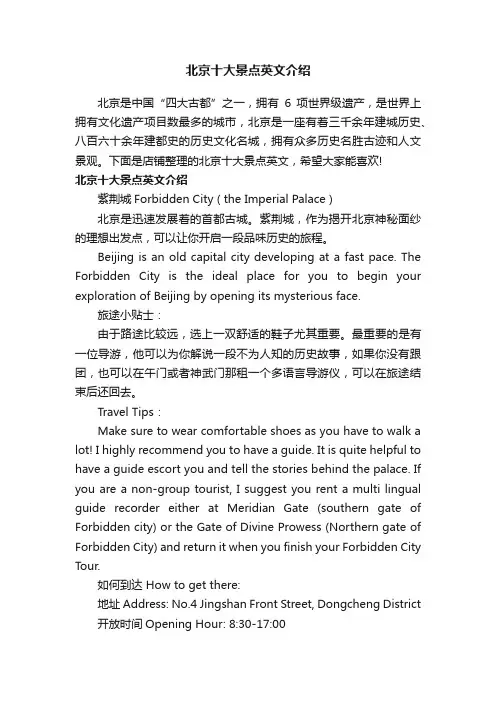
北京十大景点英文介绍北京是中国“四大古都”之一,拥有6项世界级遗产,是世界上拥有文化遗产项目数最多的城市,北京是一座有着三千余年建城历史、八百六十余年建都史的历史文化名城,拥有众多历史名胜古迹和人文景观。
下面是店铺整理的北京十大景点英文,希望大家能喜欢!北京十大景点英文介绍紫荆城Forbidden City ( the Imperial Palace )北京是迅速发展着的首都古城。
紫荆城,作为揭开北京神秘面纱的理想出发点,可以让你开启一段品味历史的旅程。
Beijing is an old capital city developing at a fast pace. The Forbidden City is the ideal place for you to begin your exploration of Beijing by opening its mysterious face.旅途小贴士:由于路途比较远,选上一双舒适的鞋子尤其重要。
最重要的是有一位导游,他可以为你解说一段不为人知的历史故事,如果你没有跟团,也可以在午门或者神武门那租一个多语言导游仪,可以在旅途结束后还回去。
Travel Tips:Make sure to wear comfortable shoes as you have to walk a lot! I highly recommend you to have a guide. It is quite helpful to have a guide escort you and tell the stories behind the palace. If you are a non-group tourist, I suggest you rent a multi lingual guide recorder either at Meridian Gate (southern gate of Forbidden city) or the Gate of Divine Prowess (Northern gate of Forbidden City) and return it when you finish your Forbidden City Tour.如何到达 How to get there:地址Address: No.4 Jingshan Front Street, Dongcheng District 开放时间Opening Hour: 8:30-17:00售票时间Ticket office hours: From 9: to 15:00 pm行程Travel Time: Two hours Entrance门票Fee: RMB 60公交路线Buses to the Forbidden City: No. 1, 2, 4, 5, 10, 20, 52, 57, 22, 54, 120, 802, special bus No.1 and get off at Zhongshan Phongshan Park stop or Tiananmen stop. Take subway.更多信息Check for more details: URL: 天安门Tiananmen Square北京最具代表性的地方有哪些?答案是各式各样的。
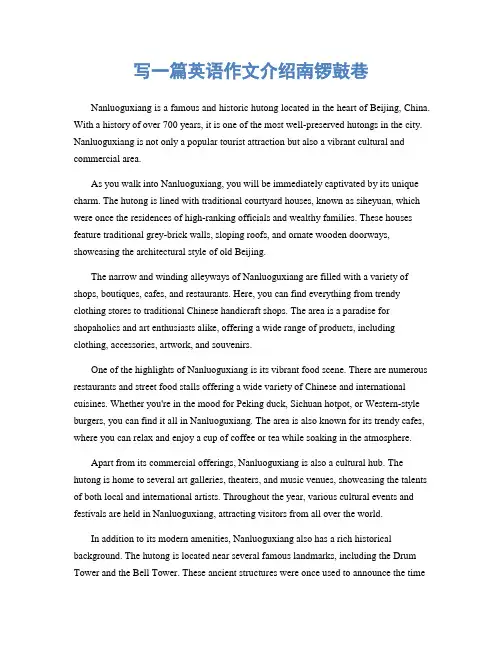
写一篇英语作文介绍南锣鼓巷Nanluoguxiang is a famous and historic hutong located in the heart of Beijing, China. With a history of over 700 years, it is one of the most well-preserved hutongs in the city. Nanluoguxiang is not only a popular tourist attraction but also a vibrant cultural and commercial area.As you walk into Nanluoguxiang, you will be immediately captivated by its unique charm. The hutong is lined with traditional courtyard houses, known as siheyuan, which were once the residences of high-ranking officials and wealthy families. These houses feature traditional grey-brick walls, sloping roofs, and ornate wooden doorways, showcasing the architectural style of old Beijing.The narrow and winding alleyways of Nanluoguxiang are filled with a variety of shops, boutiques, cafes, and restaurants. Here, you can find everything from trendy clothing stores to traditional Chinese handicraft shops. The area is a paradise for shopaholics and art enthusiasts alike, offering a wide range of products, including clothing, accessories, artwork, and souvenirs.One of the highlights of Nanluoguxiang is its vibrant food scene. There are numerous restaurants and street food stalls offering a wide variety of Chinese and international cuisines. Whether you're in the mood for Peking duck, Sichuan hotpot, or Western-style burgers, you can find it all in Nanluoguxiang. The area is also known for its trendy cafes, where you can relax and enjoy a cup of coffee or tea while soaking in the atmosphere.Apart from its commercial offerings, Nanluoguxiang is also a cultural hub. The hutong is home to several art galleries, theaters, and music venues, showcasing the talents of both local and international artists. Throughout the year, various cultural events and festivals are held in Nanluoguxiang, attracting visitors from all over the world.In addition to its modern amenities, Nanluoguxiang also has a rich historical background. The hutong is located near several famous landmarks, including the Drum Tower and the Bell Tower. These ancient structures were once used to announce the timeand are now popular tourist attractions. The nearby Prince Gong's Mansion, a well-preserved imperial residence, offers a glimpse into the grandeur of ancient China.As you stroll through Nanluoguxiang, you can immerse yourself in the rich history and vibrant culture of Beijing. The hutong's narrow alleyways, traditional architecture, and bustling atmosphere create a unique and unforgettable experience. Whether you're a history buff, a shopaholic, or a food lover, Nanluoguxiang has something to offer for everyone.In conclusion, Nanluoguxiang is a must-visit destination in Beijing. Its combination of historical charm, modern amenities, and cultural offerings make it a truly unique and vibrant place. Whether you're looking to explore the rich history, indulge in shopping and dining, or simply soak in the atmosphere, Nanluoguxiang has it all. So, don't miss the opportunity to visit this fascinating hutong and experience the best of Beijing's past and present.。
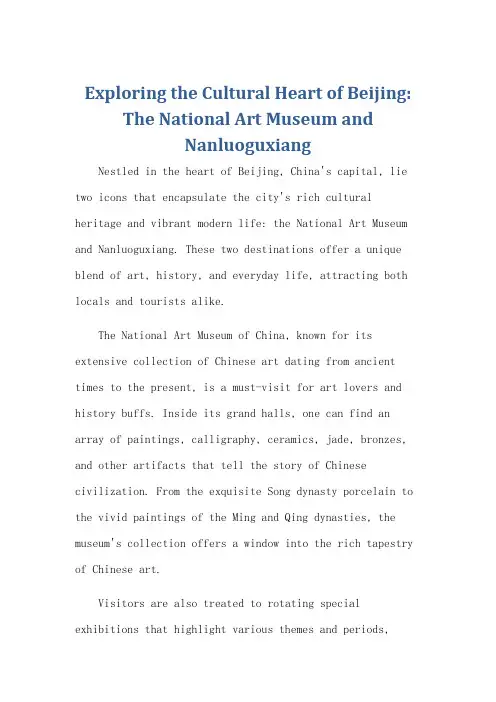
Exploring the Cultural Heart of Beijing: The National Art Museum andNanluoguxiangNestled in the heart of Beijing, China's capital, lie two icons that encapsulate the city's rich cultural heritage and vibrant modern life: the National Art Museum and Nanluoguxiang. These two destinations offer a unique blend of art, history, and everyday life, attracting both locals and tourists alike.The National Art Museum of China, known for its extensive collection of Chinese art dating from ancient times to the present, is a must-visit for art lovers and history buffs. Inside its grand halls, one can find an array of paintings, calligraphy, ceramics, jade, bronzes, and other artifacts that tell the story of Chinese civilization. From the exquisite Song dynasty porcelain to the vivid paintings of the Ming and Qing dynasties, the museum's collection offers a window into the rich tapestry of Chinese art.Visitors are also treated to rotating special exhibitions that highlight various themes and periods,providing a deeper understanding of the art and culture of China. The museum's modern design, with ample space for contemplation and learning, creates an ideal environmentfor visitors to engage with the art and its stories.Just a stone's throw away from the museum is Nanluoguxiang, a narrow lane that is a testament toBeijing's historical and cultural fabric. Once a center for imperial families and their servants, Nanluoguxiang now buzzes with the energy of local life. Its cobbled streets are lined with traditional courtyard houses, shops selling artisan crafts, and small cafes offering a taste ofBeijing's unique cuisine.Walking through Nanluoguxiang is a journey through time, where one can witness the blend of old and new. On one side, traditional shops sell goods like tea, silk, and antiques, while on the other, modern cafes and restaurants offer a respite from the hustle and bustle. The area is also hometo several cultural institutions and art galleries, further enriching the cultural experience.The National Art Museum and Nanluoguxiang offer aunique glimpse into Beijing's rich cultural identity.Whether it's the museum's collection of ancient art or the bustling life of Nanluoguxiang, these two destinations provide a profound understanding of Beijing's past, present, and future.**探索北京的文化之心:北京美术馆和南锣鼓巷**在中国首都北京的心脏地带,有两个地标性的景点,它们凝聚了北京丰富的文化遗产和充满活力的现代生活:北京美术馆和南锣鼓巷。
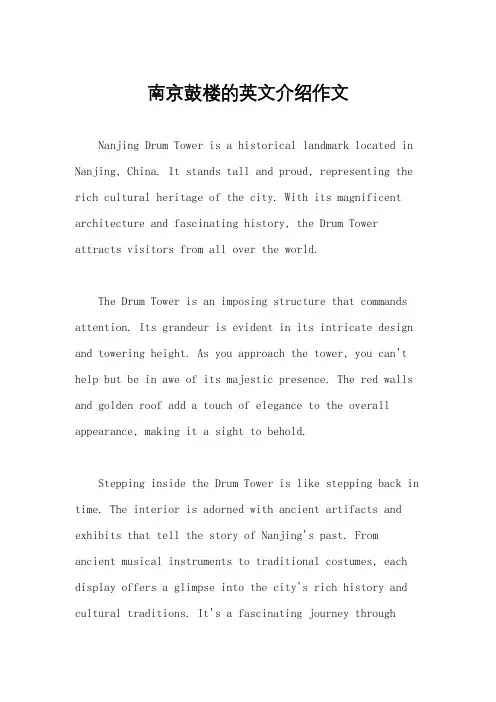
南京鼓楼的英文介绍作文Nanjing Drum Tower is a historical landmark located in Nanjing, China. It stands tall and proud, representing the rich cultural heritage of the city. With its magnificent architecture and fascinating history, the Drum Tower attracts visitors from all over the world.The Drum Tower is an imposing structure that commands attention. Its grandeur is evident in its intricate design and towering height. As you approach the tower, you can't help but be in awe of its majestic presence. The red walls and golden roof add a touch of elegance to the overall appearance, making it a sight to behold.Stepping inside the Drum Tower is like stepping back in time. The interior is adorned with ancient artifacts and exhibits that tell the story of Nanjing's past. From ancient musical instruments to traditional costumes, each display offers a glimpse into the city's rich history and cultural traditions. It's a fascinating journey throughtime, and you can't help but feel a sense of wonder and admiration.One of the highlights of visiting the Drum Tower is the opportunity to witness a drum performance. The rhythmic beats echo through the air, creating a lively and energetic atmosphere. The skilled drummers showcase their talent and precision, leaving the audience captivated. It's a truly immersive experience that allows you to appreciate the significance of drums in Chinese culture.The Drum Tower also offers a breathtaking panoramicview of the city. As you climb to the top, you are rewarded with a stunning vista of Nanjing's skyline. The bustling streets, the flowing river, and the surrounding buildings come together to create a picturesque scene. It's a momentof tranquility amidst the chaos of the city, and it's asight that you won't soon forget.In addition to its historical and cultural significance, the Drum Tower also serves as a gathering place for locals and tourists alike. The square in front of the tower isoften filled with people enjoying leisurely strolls or engaging in various activities. It's a vibrant and lively atmosphere that reflects the spirit of Nanjing. Whetheryou're looking to relax and soak in the ambiance or participate in the festivities, the Drum Tower is the perfect place to do so.In conclusion, the Nanjing Drum Tower is a must-visit destination for anyone interested in history, culture, and breathtaking views. Its grand architecture, fascinating exhibits, and lively atmosphere make it an unforgettable experience. So, if you ever find yourself in Nanjing, don't miss the opportunity to explore this iconic landmark.。
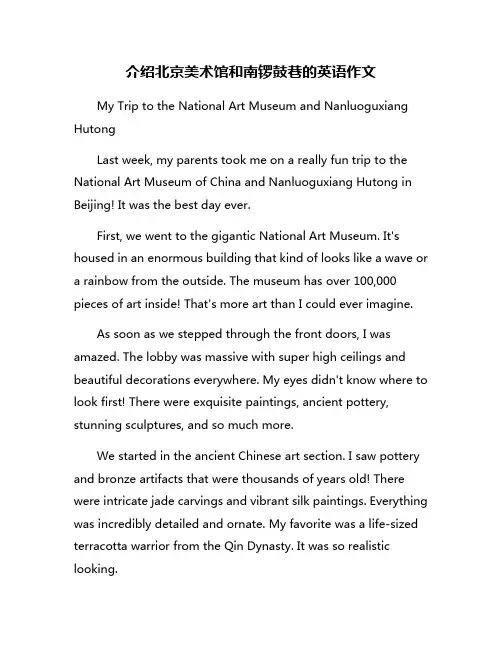
介绍北京美术馆和南锣鼓巷的英语作文My Trip to the National Art Museum and Nanluoguxiang HutongLast week, my parents took me on a really fun trip to the National Art Museum of China and Nanluoguxiang Hutong in Beijing! It was the best day ever.First, we went to the gigantic National Art Museum. It's housed in an enormous building that kind of looks like a wave or a rainbow from the outside. The museum has over 100,000 pieces of art inside! That's more art than I could ever imagine.As soon as we stepped through the front doors, I was amazed. The lobby was massive with super high ceilings and beautiful decorations everywhere. My eyes didn't know where to look first! There were exquisite paintings, ancient pottery, stunning sculptures, and so much more.We started in the ancient Chinese art section. I saw pottery and bronze artifacts that were thousands of years old! There were intricate jade carvings and vibrant silk paintings. Everything was incredibly detailed and ornate. My favorite was a life-sized terracotta warrior from the Qin Dynasty. It was so realistic looking.Next, we explored the more modern and contemporary Chinese art galleries. I loved seeing the creative styles and bright colors that the artists used. Some of the paintings looked almost like photographs, while others were completely abstract with wild brushstrokes. The contemporary sculpture garden outside was awesome too, with huge metal structures towering above me.After a couple of hours admiring all the amazing artworks, we took a break for lunch. The museum had lots of fun cafes and restaurants inside. I got to pick and ended up with some tasty noodles and dumplings!Feeling re-energized, we headed out to explore Nanluoguxiang Hutong next. A hutong is a traditional neighborhood with narrow alleys and courtyard homes. Nanluoguxiang is one of the best preserved hutongs in Beijing.As we strolled down the small lane, it felt like stepping back in time! The buildings were constructed with classic Ming and Qing dynasty architecture. Decorated wood carvings, stone engravings, and delicate landscaping lined the street. Quaint boutiques, tea houses, and snack stalls filled the storefronts. I enjoyed trying fun local snacks like sugar candies and fried dough twists.One of the coolest things was seeing families who actually live in the renovated courtyard homes along the hutong. I could picture what life must have been like hundreds of years ago in this historic neighborhood. We even stopped at a demonstration home to see the traditional residence layout and decorations.Nanluoguxiang was definitely the most lively and culturally vibrant hutong area we explored. Street performers were singing classic opera tunes and playing folk music. Artists painted calligraphy designs and sold their artwork on the alleyway. It smelled like incense and amazingly flavorful street foods around every corner.My parents and I had a photoshoot at one of the iconic photo zones so we could capture some memories. We got our pictures taken while holding decorative Chinese kites and wearing rented historical costumes. The backdrops looked straight out of an ancient Chinese painting!After hours of walking, snacking, and shopping along the lively hutong lanes, we were pretty tuckered out. What ajam-packed and educational day in Beijing! I'll definitely never forget learning about China's rich art and culture at the museum and hutong. I'm already looking forward to my next visit to explore more of this endlessly fascinating city.。
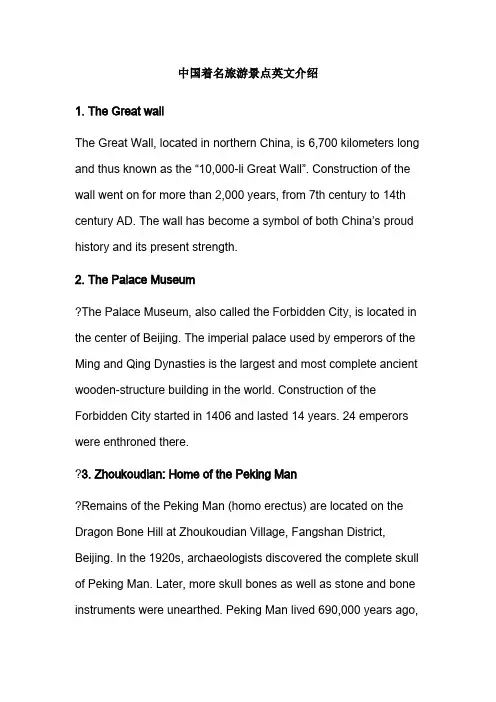
中国着名旅游景点英文介绍1. The Great wallThe Great Wall, located in northern China, is 6,700 kilometers long and thus known as the “10,000-li Great Wall”. Construction of the wall went on for more than 2,000 years, from 7th century to 14th century AD. The wall has b ecome a symbol of both China’s proud history and its present strength.2. The Palace Museum?The Palace Museum, also called the Forbidden City, is located in the center of Beijing. The imperial palace used by emperors of the Ming and Qing Dynasties is the largest and most complete ancient wooden-structure building in the world. Construction of the Forbidden City started in 1406 and lasted 14 years. 24 emperors were enthroned there.?3. Zhoukoudian: Home of the Peking Man?Remains of the Peking Man (homo erectus) are located on the Dragon Bone Hill at Zhoukoudian Village, Fangshan District, Beijing. In the 1920s, archaeologists discovered the complete skull of Peking Man. Later, more skull bones as well as stone and bone instruments were unearthed. Peking Man lived 690,000 years ago,during Paleolithic times. Findings indicate that Peking Man knew how to make fires.4. Qinshihuang’s Mausoleum and Terra-cotta Army?Qinshihuang’s Mausoleum is located in Lintong District, 35 kilometers east of Xi’an, ca pital of Shanxi Province. Construction of the mausoleum lasted 38 years and involved over 700,000 workers. Over the years, a total of 50,000 important cultural relics have been unearthed. In 1980, two bronze painted horse-drawn chariots were unearthed. They are the largest and most complete bronze chariots and horses discovered so far. In 1974, farmers who were digging a well about 1.5 kilometers east of Qinshihuang’s Mausoleum discovered three vaults containing Qinshihuang’s Buried Legion. The largest of the three vaults contains 6,000 life-size terra-cotta warriors and horses. The collection of warriors is often dubbed the “eighth wonder of the world”.5. Chengde Summer Resorts and Surrounding Temples?Chengde Summer Resort, known as “The Mountain Hamlet for Escapin g the Heat”, is located in northern Chengde, Hebei Province. Qing Emperors used to spend their summer days handling state affairs at the resort. Construction of the resort lastedfrom 1703 to 1792. It is the largest and best-preserved imperial palace outside the capital.6. Qufu, Confuc ius’ Mansion, Temple and Cemetery? Qufu, in southwestern Shandong Province, was the capital of the state of Lu during the Spring and Autumn Period (770-476 BC) and the hometown of Confucius, a great thinker and educator. Confucius’Mansion was the residence of Confucius’ eldest male descendants for generation. The mansion holds more than 9,000 volumes of archives dating from 1534 to 1948 and many cultural relics, ancient and costumes. Confucius’ Temple is famous for its 2,000 stone steles and more than 100 portrait stones from the Han Dynasty. Confucius’ Cemetery houses tombs for Confucius and his descendants.7. Ancient Buildings on the Wudang MountainThe Wudang Mountain, located in northwestern Hubei Province, is a sacred Taoist mountain that is best known as the birthplace of Wudang martial arts. The Gold Hall built on the mountain in 1416 represents advanced architectural style and building techniques of that period.8. The Lushan MountainThe Lushan Mountain, located south of Jiujiang City, Jiangxi Province, is one of the most famous mountains in China. The mountain features beautiful peaks, seas of clouds, waterfalls and historical sites. Bailu Academy is one of Chinese first schools of higher learning.9. The Emei Mountain and Leshan Giant BuddhaThe Emei Mountain is one of China’s four famous Buddhist Mountains. It is located 7 kilometers southwest of Emeishan City, Sichuan Province. There are 150 temples on the mountain. The mountain features more than 3,000 plant species and 2,000 varieties of animals. Leshan Giant Buddha is located on the east bank of the Minjiang River in Leshan city, Sichuan Province. The Buddha is carved out of a cliff and, being 70.7 meters tall, is the largest sitting Buddha in China. Carving of the Buddha started in 713 and was completed in 803. The body of Buddha has a water drainage system to prevent erosion.10. Lijiang Ancient CityLijiang ancient city, located in Lijiang, Yunnan Province, is an ancient town inhabited mainly by the Naxi minority people. The town was founded in 1127. The roads in the town are paved with colored pebbles produced in Lijiang, and there are many stonebridges and memorial archways built during the Ming and Qing Dynasties. Most of the residences are made of earth and wood. Palace murals depicting religious themes were painted during the Ming Dynasty. The traditional Dongba Culture of the Naxi ethnic group has been preserved in Lijiang.11. Pingyao Ancient CityPingyao of Shanxi Province was built 2,000 years ago during the Zhou Dynasty. The city wall was renovated in 1370. It is one of China’s earliest and largest county-level city walls. Ancient streets, government offices, markets, stores and residences have been preserved, providing invaluable resources for r esearch on China’s ancient Ming Dynasty county seat.12. Suzhou GardensSuzhou in Jiangsu Province is a famous historic and cultural city that is more than 2,500 years old. Suzhou features more than 200 ancient gardens. The small private gardens are especially famous nationwide and reflect architectural styles of the Song, Yuan, Ming and Qing Dynasties.13. The Summer Palace of BeijingThe Summer Palace, featuring the best of China’s ancient gardens, is located in the western suburbs of Beijing. The palace was built in1153 as a temporary imperial palace. It was rebuilt in 1888. The Summer Palace consists of the Longevity Hill and the Kunming Lake. The Long Corridor, painted with exquisite paintings, was included in the Guinness Book of World Records in 1992 as the longest corridor in the world. The corridor links the area where Empress Dowager Cixi handled state affairs with the residential and sightseeing areas.14. The Temple of Heaven of Beijing?The Temple of Heaven, built in 1420, is located in southern Beijing. During the Ming and Qing Dynasties, emperors came to the temple to worship the God of Heaven and pray for a good harvest.15. Jiuzhaigou Ravine(九寨沟)Located in Nanping County, Jiuzhaigou Ravine stretches 80 kilometers.The Shuzheng Scenic Spot is one of the central point of Jiuzhaigou’s landscape. With 40 lakes which extend five kilometers along a valley, the spot covers an area of three square kilometers. The lakes vary in color according to their depths, residues and scenery around them. Among which, Reed Lake is an ideal habitat of birds; Spark Lake appears to move while the jade-like Rhinoceros Lake is a good place for rowing, swimming and rafting.There are also the Shuzheng Waterfalls which have a backdrop of trees.The Sword-Shaped Rock Scenic Area consists of Goose Lake, Suspended Springs, Sword Rock, snow-covered Mountains and primeval forests. Sometimes you can see giant pandas. There is also the 17.8-kilometer Zechawa Ravine, the longest and highest in Jiuzhaigou. At the end of it is the eight-kilometer-long Changhai Lake, the largest in the area. In Haizi there is a Five-Color Pond, the brightest lake in Jiuzhaigou.Undoubtedly, the magnificent view in Jiuzhaigou will make you reluctant to leave, and don’t forget that the autumn is the best season to visit it.16. Yellow Crane Tower(黄鹤楼)Bordering on the Yangtze River and crouching on the top of the Snake Hill, the Yellow Crane Tower is one of the three most famous towers on the south bank of the Yangtze River. (the other two are Yueyang Tower in Hunan and Tengwang Tower in Jiangxi) First built in 223 AD, the tower has a history of over 1700 years. It is not only an important scenic spot, but also a symbol of "piping times of peace"(太平盛世) in people's minds. Scholars in the past dynasties wrote hundreds of poems and scores of writings in praise of the magnificent Yellow Crane Tower. The legend about the towerhas become a bright pearl of the Chinese literature.Rebuilt in 1985, the Yellow Crane Tower Park occupies a hilly area and consists of towers, pavilions and corridors, forming an architecture complex and a garden complex of man-made and natural scenery. It has become the symbol of Wuhan for its long history, its magnificent outlook and its imposing architectural style.17. Guiyuan Temple(归元寺)Guiyuan Temple, situated on Cuiwei Street, is one of the four biggest temples for Buddhist meditation in Hubei as well as an important Buddhist temple in China. It was first built in the early Qing dynasty (1644-1911) by two monks - Baiguang and Zhufeng. Guiyuan Temple has survived more than 300 hundred years of repeated cycles of prosperity and decline, and is the leading temple in Wuhan with prosperous public worship, flourishing Buddhist ceremony and many pilgrims. The temple was destroyed and rebuilt many times during the course of its history. Covering an area of 46,900 square meters with a floor space of 20,000 square meters, the temple mainly consists of Daxiongbaodian Hall, Arhat Hall, Sutra Collection Pavilion, etc. Guiyuan Temple is famous not only for spreading Buddhism throughout the whole country, but also for its perfect architecture, excellent sculpture and rich collection of Buddhist doctrine among the Buddhist temples. In 1956 GuiyuanTemple was listed as a preserved antiques unit of Hubei province and in 1983, it was appointed as one of the key Buddhist temple of Han nationality district in China by the State Council.18. East Lake(东湖)The East Lake is the pride and joy of the people of Wuhan. Millions of residents here get a lot of fun out of going for a walk along the lakeside in spring, swimming in summer, appreciating sweet laurel in autumn and admiring plum in winter.The lake covers 33 square kilometers and stretches far into the distance. Ancient pagodas and temples scattered in 34 hills around the lake make the scenic spot more historic and imposing. All the six areas of the East Lake have in common green hills, clear waters, an abundance of woods and typical style of Chu Culture. Perhaps you'll enjoy yourself most in two of them----Tingtao Pavilion and Moshan Hill.Willows dance gracefully and water lily sleeps deeply around Tingtao Pavilion, a three-storey palace building, in front of which the grand and lifelike statue of Qu Yuan is looking up at the sky and sighing sadly at the subjugation of Chu.Among all kinds of flowers, plum, lotus and cassia are of great reputation. The National Plum and Lotus Research Centre is set up here. The East Lake used to be a private farm several decades ago.In 1950 the farm was turned into a scenic spot. In 1982 the East Lake was rated by the State Council as one of the first group of national key resorts. It receives more than two millions tourists a year.19. First Bridge over the Yangtze River(长江一桥)For hundreds of years, it had been a dream to cross the natural moat of the Yangtze River.After the founding of New China, the central government decided to build the Yangtze River Bridge in Wuhan in 1950. Five years later, news came that the construction would soon begin and it became the focus of world attention. However, more overseas people were half believing and half doubting. Within two years, the Chinese engineers, technicians and workers, with the help of the Soviet experts, completed a double-deck bridge for the dual use of automobiles and trains. The wish of "turning a deep chasm into a thoroughfare" was fulfilled.On October 15, 1957, thousands of people in Wuhan were overexcited. Cheering sound could be heard on and under the bridge. Trains, automobiles and pedestrians safely crossed the bridge.More than 30 years have passed. The Wuhan Bridge Bureau of the Railway Ministry has built other ten bridges over the YangtzeRiver in Nanjing, Chongqing, Zhijiang and Jiujiang.。
南锣鼓巷英语作文简短南锣鼓巷(Nanluoguxiang)是北京市东城区的一条胡同,以其悠久的历史、独特的建筑风格和丰富的文化氛围而闻名。
以下是一篇简短的英语作文,介绍了南锣鼓巷的历史、文化和景观。
---。
Nanluoguxiang: A Glimpse into Beijing's Rich Heritage。
Nanluoguxiang, nestled in the heart of Beijing's Dongcheng District, is not just a typical alleyway; it's a portal to the city's rich history and cultural heritage. Dating back to the Yuan Dynasty, this ancient alleyway has witnessed centuries of transformation, yet it proudly retains its traditional charm amidst the bustling modern cityscape.Stepping into Nanluoguxiang feels like embarking on a journey through time. The narrow lanes, lined with quaint courtyard houses known as "siheyuans," whisper tales ofdynasties past. Each siheyuan exudes its own distinct character, adorned with intricate wood carvings, colorful door frames, and elegant eaves, reflecting thearchitectural splendor of ancient China.But Nanluoguxiang isn't just about its physical beauty; it's a melting pot of cultural diversity. As you stroll along its cobblestone streets, you'll encounter a vibrant tapestry of shops, cafes, and art galleries, each offering a glimpse into Beijing's contemporary arts scene. From traditional handicrafts to modern street art, Nanluoguxiang celebrates both the old and the new, bridging the gap between tradition and innovation.One of the highlights of Nanluoguxiang is its culinary scene. Food enthusiasts flock to this alleyway to savor authentic Beijing cuisine, from savory jianbing (Chinese crepes) to aromatic lamb skewers. The aroma of freshly brewed tea wafts through the air as traditional teahouses invite visitors to unwind and immerse themselves in the serene ambiance.Beyond its architectural and culinary delights, Nanluoguxiang pulsates with cultural activities throughout the year. From traditional folk performances to modern art exhibitions, there's always something happening in this dynamic alleyway. Local residents and tourists alike come together to celebrate festivals, such as the LanternFestival and Mid-Autumn Festival, adding to the festive atmosphere of Nanluoguxiang.In recent years, Nanluoguxiang has undergone revitalization efforts to preserve its historical charmwhile adapting to the demands of modern urban life. Conservation projects have restored dilapidated siheyuans, while efforts to pedestrianize the alleyway have created a more pedestrian-friendly environment. Despite the rapidpace of urban development, Nanluoguxiang remains asanctuary of tranquility amidst the urban chaos—atestament to Beijing's enduring cultural legacy.In conclusion, Nanluoguxiang is more than just a street; it's a living museum of Beijing's heritage, a vibrant hubof creativity, and a testament to the resilience oftradition in a rapidly changing world. Whether you're a history buff, an art aficionado, or a food lover, Nanluoguxiang offers a treasure trove of experiences waiting to be discovered. So, next time you find yourself in Beijing, don't miss the opportunity to wander through the ancient alleyways of Nanluoguxiang and immerse yourself in its timeless charm.。
西安旅游景点英文介绍带图片SANY标准化小组 #QS8QHH-HHGX8Q8-GNHHJ8-HHMHGN#西安旅游景点英文介绍(带图片)大雁塔GreatWildGoosePagoda小雁塔SmallWildGoosePagoda鼓楼TheDrumTower钟楼TheBellTower西安城墙TheXi’anCircumvallation大唐芙蓉园LotuspalaceofTangDynasty秦始皇兵马俑博物馆MuseumofEmperorQinshihuang ’sTomb FiguresofSoldiersandHorses秦始皇陵TheTombofEmperorQinshihuang黄帝陵TheHuangdiTomb华清池TheHuaqingPond乾陵TheQianTomb法门寺TheFamenTemple黄河壶口瀑布TheHuangheHukouWaterfall1. Xi'an city wall 西安城墙景区地址:西安市南门里 Xi'an city wall is located in the center of the city---- Total perimeter kilometers. The existing walls were built during the sevenyears to eleven years (1374 hongwu--- 1378 hongwu) , it’s the oldest shape in the world, the most spectacular and best-preserved ancient buildings.Ticket: 40 yuanCard discount: Open-times free admission tours, excluding Mid-Autumn Festival, holiday, Chinese New Year Lantern Festival Phone :029 -,By car: take the city bus to arrive at the South Gate , North Gate, West Gate, or East Gatebus stop大雁塔GreatWildGoosePagoda大唐芙蓉园LotuspalaceofTangDynastySituated in Huayin City, 120 kilometers (about 75 miles) east from Xi'anCity of Shaanxi Province, Mt. Huashan is known as 'The Number Mountainunder Heaven'.It is one of the five sacred mountains in China. The other fourmountains are Mt. Taishan in Shandong, Mt. Hengshan in Hunan, Mt. Hengshan inShanxi, and Mt. Songshan in Henan. In ancient times, Mt. Huashan was called Mt.Taihuashan. From a distance the five peaks seem to form the shape of a 'flower'(hua in Chinese), hence the name 'Huashan'. It is famous for its natural vistas of steep and narrow paths, precipitous crags, and a high mountain range. It is home to several influential Taoist temples where emperors of past dynasties madepilgrimages, making Mt. Huashan the holy land of Taoism.。
介绍城市的英语作文初一(中英文实用版)**English Version:**Title: A Glimpse of a CityIn the vast tapestry of the world, cities are like shining pearls, each with its unique brilliance.Today, I would like to introduce a city that holds a special place in my heart.The city I want to talk about is Beijing, the capital of China.Beijing is not only a political and cultural center but also a city rich in history.It is a place where ancient traditions and modern advancements blend harmoniously.One of the most famous landmarks in Beijing is the Forbidden City, also known as the Palace Museum.It was the Chinese imperial palace from the Ming dynasty to the end of the Qing dynasty.Walking through its vast courtyards and intricate halls, one cannot help but feel the weight of history.Another must-see attraction is the Great Wall, which stretches over 21,196 kilometers from east to west of China.It is a testament to the engineering prowess and determination of ancient Chinese people.Standing on the Great Wall, one can"t help but marvel at the grandeur of this man-made wonder.Beijing is also famous for its vibrant street life and delicious localcuisine.Strolling through the bustling streets of Wangfujing or the historic alleys of Nanluoguxiang, you can savor local delights such as Peking duck, a dish that has been enjoyed by emperors and commoners alike for centuries.Moreover, Beijing is a city of modern wonders.The skyscrapers in the Central Business District and the cutting-edge technology in Zhongguancun demonstrate China"s leap into the future.The city hosted the prestigious Olympic Games in 2008, further showcasing its global presence.In conclusion, Beijing is a city that perfectly encapsulates the essence of China"s past and present.It is a city worth exploring, where every corner has a story to tell.**中文版本:**标题:城市的简介在世界这幅宏伟的织锦中,城市就像是一颗颗璀璨的明珠,每一颗都有其独特的光彩。
天津十大景点英文介绍天津是中国北方的重要城市,拥有许多著名的旅游景点。
以下是天津的十大景点的英文介绍:1. The Ancient Cultural Street (古文化街): This vibrant street is filled with shops offering traditional Chinese crafts, artworks, and snacks, providing visitors a glimpse into Tianjin's rich cultural heritage.2. The Tianjin Eye (天津之眼): Standing at a height of 120 meters, the Tianjin Eye offers breathtaking panoramic views of the city, making it an iconic landmark and a must-visit spot for tourists.3. The Porcelain House (瓷房子): This unique architectural marvel is decorated with over 400 million Chinese porcelain pieces, making it one of the most extravagant and artistic buildings in the world.4. The Haihe River Scenic Area (海河风景区): The Haihe River, which flows through the heart of Tianjin, offers stunning views of the city's skyline, bridges, and historical landmarks, making it an ideal spot for a leisurely stroll or boat ride.5. The Five Great Avenues (五大道): This historic district features a collection of well-preserved European-style buildings,offering visitors a glimpse into Tianjin's past as a treaty port and international settlement.6. The Yellow Street (洋货市场): This bustling market offers a wide variety of goods, including antiques, clothing, and souvenirs, providing visitors a unique shopping experience anda chance to interact with locals.7. The Drum Tower (鼓楼): This iconic tower, located in the center of Tianjin, offers visitors a glimpse into the city's rich history and cultural heritage, with its intricate architecture and surrounding historical landmarks.8. The Tianjin Ancient Temple (大悲禅院): This serene Buddhist temple complex offers visitors a chance to experience peace and tranquility in the heart of the city, with its intricate architecture and beautiful gardens.9. The North Bund Scenic Area (意式风情街): This charming district features a collection of well-preserved Italian-style buildings, offering visitors a glimpse into Tianjin's past as a treaty port and international settlement.10. The Zhongyuan Temple Fair (娘娘庙庙会): This lively temple fair, held at the Zhongyuan Temple, offers visitors a chance to experience traditional Chinese culture and customs, with its colorful performances, delicious food stalls, andbustling crowds.。
南锣鼓巷中英文介绍 Company number:【0089WT-8898YT-W8CCB-BUUT-202108】South Luogu LaneAlso called Nanluoguxiang, Nanluogu Alley, Nanluoguxiang Hutong, 南锣鼓巷) South Luogu Lane is 786 meters long and 8 meters wide, connecting Gulou East St. on its north and Di’anmen East St. on the south. South Luogu Lane was built in 1267 when Yuan Da Du was constructed, and was a component of the market area in Yuan Da Du’s urban layout, which had the imperial government built in the front, the market area at the back, the imperial ancestral temple on the left, and the sacrificial altar on the right. The lane was part of the Zhaohui Community in the Yuan Dynasty, and served as the dividing line between the Zhaohui community and the Jinggong Community in the Ming Dynasty. It was under the jurisdiction of the Xianghuang Banner during the years of Emperor Qianlong, and belonged to the Left III Community in the late years of Emperor Guangxu and during the years of Emperor Xuantong. During the Republic of China years, it belonged to the Inner V Community.The Lane was called “Luoguo Lane” in the Ming Dynasty due to its “luoguo”feature with the middle part higher than the two ends. In 1750, the lane got a homonymic name of “Luogu Lane”, and was divided into South Luogu Lane and Northern Luogu Lane(now within the Andingmen Community). The name of the lane remained “South Luogu Lane” during and after the years of the Republic of China. The Hutong was briefly called “Huihuang St.” during the Cultural Revolution and later regained its current name.South Luogu Lane was built under the architectural concept of “residential blocks”– with the lane serving as the central line dividing 8 parallel Hutongs on each side, hence forming the outlook of a fish bone, or a “Wugong”. Thus, the lane was also called “Wugong Lane”. South Luogu Lane is the only remaining traditional residential area in China that still fully preserves the chess-board style layout of Hutongs typically found in the Yuan Dynasty, with its scale, quality and historical value unmatched by any other lanes.South Luogu Lane was among the first 25 areas listed for historical preservation by the Beijing Municipal Government in November 1990. Currently, within the South Luogu Lane area, one site has been listed for national level preservation, 11 sites for municipal level preservation, and 9 sites for district level preservation. With its impressive historical and cultural legacy, South Luogu Lane has become an attractive area for tourism and cultural creativity in the ancient capital Beijing.Today, South Luogu Lane is among one of the oldest Hutongs around and has a history of over 800 years. This near 800-meter long North-South alleyway is filled with bars, cafes, restaurants, artsy little shops, souvenir shops and cute boutiques. It's worth to spend an hour or two walking through the little alley ways and Hutongs around it.Location: South Luogu Lane is situated at Beijing’s Dongcheng District, near the with its northern end at Gulou Dongdajie (Drum Tower East Street, 鼓楼东大街) (WalkEast along Guloudong Dajie about 10-15min past the Drum Tower and look out for the street sign pointing the way to the hutong on your right-hand side.) and the southern end of Nanluogu xiang can be found at Di’anmen Dongdajie (地安门东大街).南锣鼓巷简介北起鼓楼东大街,南至地安门东大街,全长786米,宽8米。
南锣鼓巷英语作文简短很高兴有机会来谈谈我喜欢的地方——南锣鼓巷。
这是一个充满历史和文化气息的地方,也是北京市的一个著名景点。
我经常去那里散步,感受那里的独特魅力。
英文,I am so excited to talk about my favorite place Nanluoguxiang. It is a place full of history and cultural atmosphere, and also a famous tourist spot in Beijing. I often go there for a walk and enjoy the unique charm of the place.中文,南锣鼓巷是一个非常有特色的地方,有着古老的胡同和现代的文艺气息。
这里有很多小店铺,卖着各种有趣的手工艺品和特色小吃。
我记得有一次我在那里发现了一家卖手工皮具的店铺,我买了一个手工制作的皮包,质量非常好,价格也很合理。
英文,Nanluoguxiang is a very unique place, with ancient hutongs and a modern artistic atmosphere. There are many small shops selling various interesting handicrafts and local snacks. I remember one time I found a shopselling handmade leather goods there, and I bought a handcrafted leather bag, which was of great quality and at a reasonable price.中文,除了购物,南锣鼓巷还有很多有趣的文化活动。
我曾经参加过一次在那里举办的传统手工艺品展览,看到了很多传统的手工艺品,还有一些手工艺人在现场展示他们的技艺。
南锣鼓巷中英文介绍 This manuscript was revised on November 28, 2020
South Luogu Lane
Also called Nanluoguxiang, Nanluogu Alley, Nanluoguxiang Hutong, 南锣鼓巷)
South Luogu Lane is 786 meters long and 8 meters wide, connecting Gulou East St. on its north and Di’anmen East St. on the south. South Luogu Lane was built in 1267 when Yuan Da Du was constructed, and was a component of
the market area in Yuan Da Du’s urban layout, which had the imperial government built in the front, the market area at the back, the imperial ancestral temple on the left, and the sacrificial altar on the right. The
lane was part of the Zhaohui Community in the Yuan Dynasty, and served as
the dividing line between the Zhaohui community and the Jinggong Community
in the Ming Dynasty. It was under the jurisdiction of the Xianghuang Banner during the years of Emperor Qianlong, and belonged to the Left III Community in the late years of Emperor Guangxu and during the years of Emperor Xuantong. During the Republic of China years, it belonged to the Inner V Community.
The Lane was called “Luoguo Lane” in the Ming Dynasty due to its “luoguo” feature with the middle part higher than the two ends. In 1750,
the lane got a homonymic name of “Luogu Lane”, and was divided into South Luogu Lane and Northern Luogu Lane(now within the Andingmen Community). The name of the lane remained “South Luogu Lane” during and after the years of the Republic of China. The Hutong was briefly called “Huihuang St.” during the Cultural Revolution and later regained its current name.
South Luogu Lane was built under the architectural concept of
“residential blocks”– with the lane serving as the central line dividing 8 parallel Hutongs on each side, hence forming the outlook of a fish bone,
or a “Wugong”. Thus, the lane was also called “Wugong Lane”. South Luogu Lane is the only remaining traditional residential area in China that still fully preserves the chess-board style layout of Hutongs typically found in
the Yuan Dynasty, with its scale, quality and historical value unmatched by any other lanes.
South Luogu Lane was among the first 25 areas listed for historical preservation by the Beijing Municipal Government in November 1990. Currently, within the South Luogu Lane area, one site has been listed for national
level preservation, 11 sites for municipal level preservation, and 9 sites
for district level preservation. With its impressive historical and cultural legacy, South Luogu Lane has become an attractive area for tourism and
cultural creativity in the ancient capital Beijing.
Today, South Luogu Lane is among one of the oldest Hutongs around and
has a history of over 800 years. This near 800-meter long North-South alleyway is filled with bars, cafes, restaurants, artsy little shops,
souvenir shops and cute boutiques. It's worth to spend an hour or two walking through the little alley ways and Hutongs around it.
Location: South Luogu Lane is situated at Beijing’s Dongcheng District, near the with its northern end at Gulou Dongdajie (Drum Tower East Street, 鼓楼东大街) (Walk East along Guloudong Dajie about 10-15min past the Drum Tower and look out for the street sign pointing the way to the hutong on your right-hand side.) and the southern end of Nanluogu xiang can be found at Di’anmen Dongdajie (地安门东大街).
南锣鼓巷简介
北起鼓楼东大街,南至地安门东大街,全长786米,宽8米。
南锣鼓巷与元大都(1267年)同期建成,在元大都“左祖右社,面朝后市”的城市格局中,南锣鼓巷是“后市”的组成部分。
元代,以南锣鼓巷为轴线,东侧地区属昭回坊,西侧地区属靖恭坊。
明代属昭回靖恭坊。
清代乾隆年间属镶黄旗,光绪末年至宣统年间属内左三区。
民国时期属内五区。
南锣鼓巷,明代称锣锅巷。
清乾隆十五年(1750年)改称锣鼓巷,并分为南锣鼓巷和北锣鼓巷(北锣鼓巷在今安定门街道辖区内)。
南锣鼓巷之名,因其地势中间高、南北低,如一驼背人,故名罗锅巷,后音转为锣鼓巷。
民国后沿称。
“文化大革命”中一度改称辉煌街,后恢复原名。
南锣鼓巷在元大都初建时,沿用了“里坊制”建筑思想,其架构以南锣鼓巷为轴线,两侧各对称分布着8条平行胡同,呈“鱼骨状”,又如同一条“蜈蚣”。
因此,南锣鼓巷也称为“蜈蚣巷”。
她是我国唯一完整保存着元代胡同院落肌理、规模最大、品级最高、资源最丰富的棋盘式传统民居区。
1990年11月,南锣鼓巷列入北京市政府批准的第一批25片历史文化保护区。
现有全国重点文物保护单位1处,北京市文物保护单位11处,东城区文物保护单位10处,历史文化遗存十分丰富,是古都北京休闲旅游和文化创意的着名街区。